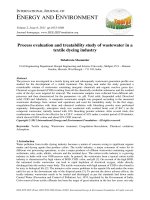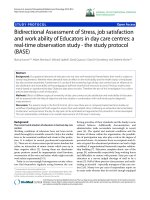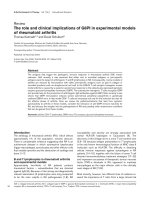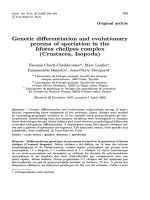flesh and the devil clarence brown technical devices and cinematic movements of 1920s in the construct
Bạn đang xem bản rút gọn của tài liệu. Xem và tải ngay bản đầy đủ của tài liệu tại đây (39.7 KB, 3 trang )
The narrative and visual story of Clarence Brown's Flesh and the Devil is constructed through
technical device of the 1920s and cinematic movements of this period. Mise en scene within the
sequence establishes the way that the characters are understood and heightens the drama of the
film.
Only a few significant technical advances occurred during the 1920s. A new approach to
cinematography introduced a creation of soft and blurred images, rather than the hard-edged,
sharp tones of previous films. This new approach to cinematography is used in Flesh and the
Devil; examples of this soft blurry image are mainly used to describe female or the 'morally' good
characters within the sequence. This technique constructs the way in which a character is
perceived. Throughout the sequence the young woman dressed in white is described in this way,
as are the characters of 'David' and the 'Wife of Uriah' after they have drunken from the wine
goblet. This is noticeable as prior to this event 'David' was shown under a more contrasted light.
This technique allows the audience to assume his redemption. The contrast of this focus also
determines the characters morals and intentions. This technique establishes the construction of
narrative and visual story without the reliance of dialogue within the sequence.
One of the main German trends in cinematography in the 1920s was expressionism. It relied on
drama and spectacle to convey the story, with distorted and exaggerated sets, costume and make
up. The ideas and techniques used in Flesh and the Devil oppose the expressionist genre of film.
As it portrays a realistic and naturalized narrative. Images appear to be realistic as this sequence is
taken through a normal lens, to show the image without exaggerating or reducing the planes within
the scene. This is used to portray an everyday scene so greater focus can be placed on character
emotion through evocative acting and detail within the sequence. To construct narrative and
emotive response, without the reliance on dialogue. Characters facial expression and gesture is
emphasized to reveal the narrative, this is shown through subtle body language and gesture of the
characters of 'David' and the 'Wife of Uriah,' which allude to the condemnation of a certain act
which has taken place in the chain of events.
Kammerspiel another German trend of the 1920s, was also a movement opposed to German
Expressionism. It was another influence in the social realistic narrative portrayal and visual story
of Flesh and the Devil. In many ways the influences and similarities of Kammerspiel are shown in
this sequence. The sequence is set in a small intimate setting, although many people are shown
only a few of the characters are focused on in detail, while the other people have no prominence.
Within the sequence these characters are explored and an aspect of the crisis of their lives is
detailed, through evocative acting and expression. Like Kammerspiel it is focused on character
psychology rather than extreme expression of emotion and spectacle. Flesh and the Devil also
eliminates notions of fantasy or legend, using mundane, banal settings and conveying a short
period of time. This portrayal of contemporary reality within the sequence, allows for the visual
story and narrative to take prominence. Although unlike most Kammerspiel films it is more
complex and uses inter titles, to aid in detailing plot and character emotion. Although there are
noticeable differences that differentiate this film from the Kammerspiel movement, again likeness
can be seen through the symbolism. Symbolism is important in the conveyance of narrative events,
as it is a visual clue to the action. Such motifs within the sequence are colour; white, the crucifix
and the wedding band. These motifs show a parallel to the sequence as they all reference virtue
but contradict what they represent. As within the sequence, it is set in a 'holy' place, but we are
aware of sinful acts that have occurred.
New Objectivity is another trend that has influenced the style and techniques of Flesh and the
Devil. Like Kammerspiel it influenced the film in its move away from contorted expressionism
and shift towards realism and social criticism. This is evident in the sequence through the use of
evocative acting, gesture and facial expression. New Objectivity focused on the subject matter of
the film, often depicting many social ills. This is portrayed within the sequence through the sinful
act of 'David' and the 'Wife of Uriah' which is alluded to by the minister and by the characters
gestures and reaction, rather than the use of dialogue. Within this trend ironies of the social
situation take precedence over that of extreme emotion. Dramatic irony of the social situation
within the sequence takes place through the contrast of the setting; a church and the situation that
is alluded to; an act of sin. This irony also comes across through the innuendo of the sequence, as
the act is suggested through reading of the bible.
Through the ideas of New Objectivity, Kammerspiel and other techniques, Clarence Brown is able
to construct the narrative and visual story without the use of dialogue.
The mise en scene within Flesh and the Devil establishes the way the characters are construed,
creating a sense of drama and innuendo within the sequence.
The use of props within the mise en scene effects a characters portrayal and heightens the dramatic
and visual aspects of the sequence. The hand written note is the first prop of significance. The
harsh whiteness of the paper contrasts the general bleakness of the setting, while the content
conflict with the action of the film and the undertones of the minister's impromptu sermon. The
extreme close up of the minister's hand destroying the note delivers a sense of exacerbated tension
within the mise en scene.
Many of the props within the mise en scene construct power relations between characters. The
minister's glasses illustrate this as he looks upon the mass with scrutiny. He puts on the glasses to
read the note, but removes them when the people involved in the sinful act arrive As if he only
wants to see the purity in the world and refuses to look upon sin. Within the mise en scene other
important props creating power relations are the bible and the glass of water. Both representing
virtue and purity, implying this of the minister. Through drinking the water he purifies himself and
through his teachings from the bible he instills this sense of purity in others. Although the
prominence of his wedding band implies that he too is human, not 'God' and that he has needs and
desires, perhaps making him not so virtuous.
The character metaphorically labeled 'Uriah's Wife' is also empowered through the use of prop
within the mise en scene, as it influences the way she is perceived. Her application of lipstick
gives her a seductive and femme fatale air. It gives her power, power over the male characters, and
almost a power over 'god' as she does not fear this moral ideal. She can hide behind the lipstick as
it covers her sins.
The minister again is in a position of power as he places the bread the mouths of the recipients, as
with the wine. All the characters are subservient to the Ministers status. Although there is a shit in
power when the ' Wife of Uriah' submits. She grasps the goblet with both hands as to take full
control, a mortal control.
The figure of the Virgin Mary or Jesus Christ is also noted near the end of the sequence within the
mise en scene. Only the head of the statue is shown, and it is always seen in darkness and out of
focus. Although it is situated above the people and above the minister.
Costume within the mise en scene creates a sense of contrast and construes the nature and
intentions of a character. Through out the sequence prominent contrasts of black and white are
obvious. The predominant colour is black; this is recognized in the characters involved in the
sinful act. One young lady in their procession whom is clothed completely in white contrasts these
characters. She appears to be pure and virginal, almost bride like as she proceeds up the aisle. In
the last shot of the sequence her lightness and luminosity is featured, portraying her as perhaps the
ideal pure figure. This costume provides an outstanding contrast to that of the 'Wife of Uriah'
whom is clad almost in black. Emphasis is put on the black gloves she wears, as the hands of the
other characters are bare. This is highlighted in the shot showing bare white hands putting coins
into the dish. Like the lipstick, her gloves cover up and hide her sin.
The use of lighting within the mise en scene acts in a similar way, providing a significant contrast
between light and dark within the sequence, to establish character and drama. Throughout most of
the sequence low-key lighting is used for the characters of 'David' and the 'Wife of Uriah'. These
shots are interspersed with shots of the minister, which have a lesser light contrast. This usage of
lighting defines characters and allows a differentiation of the sinfulness of 'David' and the 'Wife of
Uriah' and the holiness of the Minister. The character of the Minister is also established through
the high angle shot of the back of his head, as a strong key light is used to light one side of his
head, giving a halo effect. Perhaps indicating that he is not entirely virtuous. The woman dressed
in white is described through lighting as she is seen in a soft focus and given a luminous quality.
Within the last shot of the sequence lighting on her face is emphasized, as to portray a kind of
innocence and purity. Direct sources of light distinguish certain significant features within the
mise en scene. A strong light streams through the window in rays, implying the church as a
heavenly and holy place. This idea is again shown through the light, which comes from the open
door, emphasizing the crucifix, which hangs above it. A shift in the use of light is noticed near the
end of the sequence. After 'David' and the 'Wife of Uriah' have repented their sins through
drinking the wine the lighting of their figures changes from a low key lighting to becoming less
contrasted, signifying this. This use of light within the mise en scene empowers the sequence
through the contrast of dark sinister undertones with interspersed moments of lightness.
Within the mise en scene body language and gesture describe emotion power and relations
between characters. This is significant for the portrayal of the Minister, 'David and the 'Wife of
Uriah'. This trip tych of expression reveals the power struggle of these characters. Through the
minister strong movement, facial expression and direct gesture, establish the Ministers apparent
want for control. The character who does have control though is the "wife of Uriah'. This is shown
through her nonchalance, her sexual feminine gesture; fainting and applying lipstick, as well as
more direct gestures in taking hold of the wine goblet. Within this trip tych of power it is apparent
that 'David ' is the subservient party. This is conveyed through his stunned reaction to he sermon,
his overall anxious agitation and hi reluctance to stand for the hymn or drink from the goblet.
Within the sequence there is a direct contrast between Ministers strong movement and the subtle
innuendo of 'David' and 'Uriah's wife' is also noted.
Aspects of the mise en scene within the sequence contribute to the conveyance of power, relations
and emotion to establish the development of character and drama in Flesh and the Devil.









